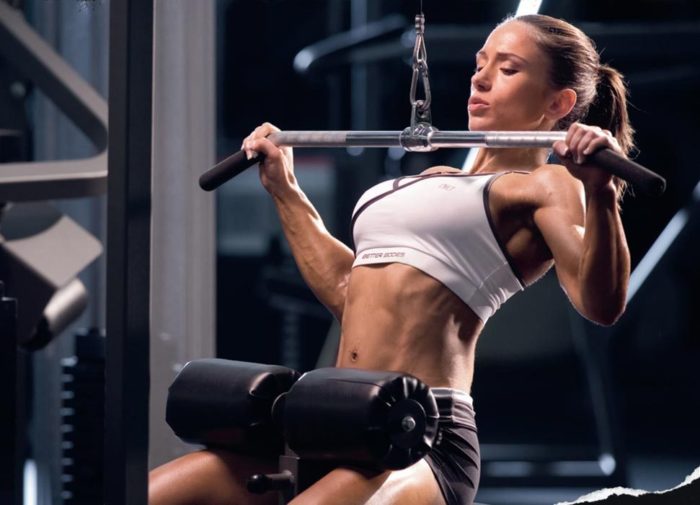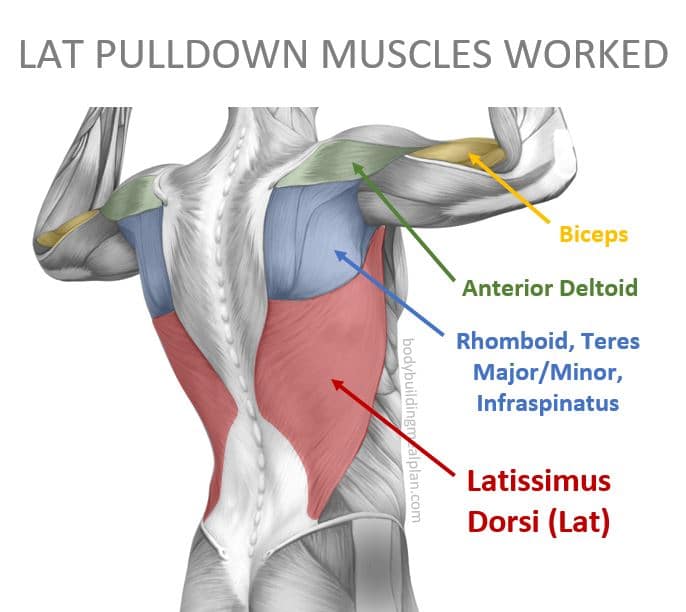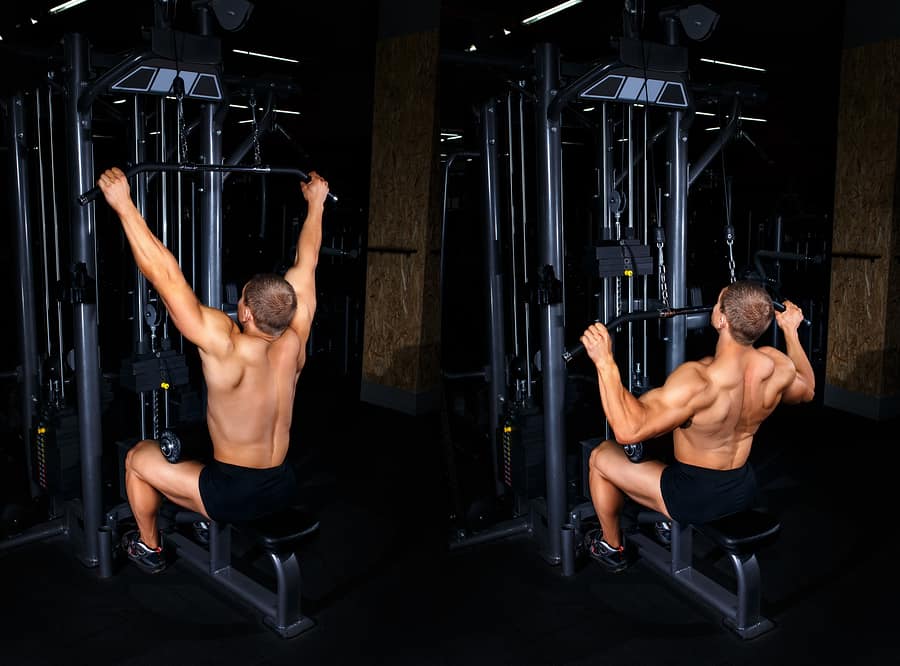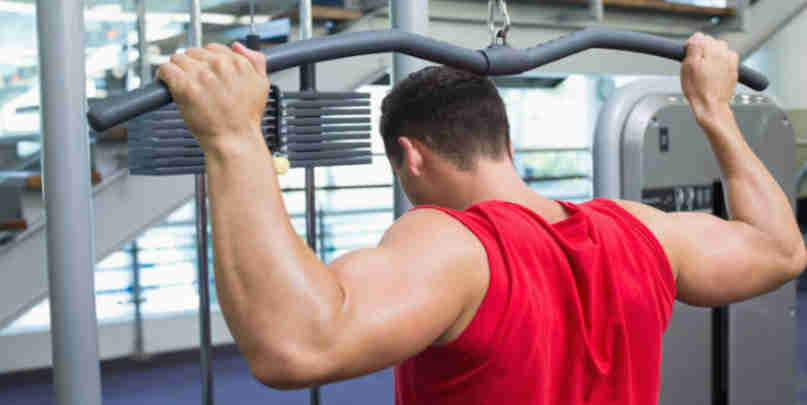What are lat pulldowns?
Lat pulldowns are a resistance exercise that target the Latissimus Dorsi muscles in the mid-back. It is performed on a lat pulldown machine or a cable pulley machine with a pulldown bar.
Pulldown machines are a common feature in modern gyms as they provide a great way for activating muscles in the back with a variety of different grips.
Which muscles are worked with lat pulldowns?
The main muscle activated is the Latissimus Dorsi, otherwise known as the 'lat' hence the name of the exercise, the lat pulldown. The lats are the muscles responsible for the rowing movement of the arms and are used in most back-focused movements.
There are a few secondary movers and stabilisers involved with lat pulldowns. The rhomboids above the lats and rear deltoids all assist in the movement of the back and the biceps help to pull the bar down.
To a lesser extent, the forearms are responsible for gripping the bar and the lower back for stabilising the core.
It is possible to target the lats in different ways by adjusting the grip used on the pulldown bar. Using a wide grip is said to promote width in the lats giving the back its 'V' shape while using a narrow or underhand grip is believed to add thickness to the lats.
Adding thickness adds to upper body mass and a thicker frame. Some people opt for a hammer grip which is neutral and will target the thickness and width.
There is still much debate on the grips used for lat pulldowns. While the majority believe that wide grip pulldowns will promote width, others swear by strict, heavy narrow grip rows for width.
For this reason, it is advisable to try a variety of grips over your split until you can feel which one provides the most benefit to you.
Advantages of performing lat pulldowns
If you are a bodybuilder, wide, thick lats are essential. They, define the entire back by giving it the 'V' shape and adding mass to the upper body. It is one of the first things that competition judges look for, which is why professional bodybuilders spend so much time on their pulldowns.
Strength trainers and athletes also benefit from strong lats as it helps with pulling and rowing movements. If you want to increase your deadlift PB, developing strong lats will certainly help.
For the casual trainer, having strong lats will give you a good aesthetic appearance, improve your posture and help prevent back injury.
A lot of professional lifters swear by the theory that for every pressing movement you perform in the gym, you should perform two back movements.
How to do lat pulldowns
Lat pulldowns are usually performed on a lat pulldown machine. These are usually cable machines with a weight stack and a seat pad with a support to tuck your thighs under. Some gyms opt for heavier plate-loaded machines.
These tend to be much bigger and capable of handling a heavier load making them useful for advanced trainers. If your gym has neither, you can perform lat pulldowns on a cable pulley machine but will be limited to the weight you can pull due to the lack of support holding you down.
- Select your weight from the weight stack or load your weight plates on.
- Grab the bar with a wide, overhand grip.
- Sit down and tuck your legs underneath the supports.
- Keep a straight back, lean back slightly and engage your core to keep a rigid position.
- Pull the bar down towards your chest and squeeze the shoulder blades together.
- Hold this position before letting the bar slowly return to its start position.
- Repeat for the required number of reps and sets.
Tips for performing lat pulldowns
There are a few different ways that you can improve your lat pulldown for better results.
Breathing.
This is an essential part of all resistance movements. Make sure that you are controlling your breathing and getting plenty of oxygen into your blood for each rep. Typically, you will take a few deep breaths before performing any heavy lifts. Breath in and exhale as you push or pull the weight under exertion.
Do this with each following rep. Breath in on the negative motion and out on the positive motion. If it is a slow negative motion, take two or three shorter breaths to get as much oxygen into the body as possible.
Support.
It is a good idea to use a variety of supports when lifting heavy. This includes a belt for lower-back stability and injury prevention, elbow straps if your joints are not strong, and wrist straps if you do not have great wrist straps.
Strength trainers will advise against wrist straps as grip strength is important to them, but if you are training for hypertrophy there is no reason not to wear them. It helps you to focus on muscle engagement as you are not worried about letting go of the bar.
Warming up.
As with all resistance exercises, it is important to warm up the target muscles, joints and to get the blood pumping. A good warmup exercise for lat pulldowns would be the rowing machine as it gets blood into the lats and warms up the core muscles.
Following this with some dynamic stretching and then some lighter sets before starting your working sets.
Variations of lat pulldown.
There are a few different variations of lat pulldowns. We have already looked at the wide grip pulldown, so here are a few other options.
V bar pulldown.
The V-bar is an attachment that adds on to a cable lat pulldown machine. It allows you to use a narrow grip with your palms facing towards each other so that there is not too much tension on the wrist joints.
Using a V-bar as opposed to a wide grip bar allows you to focus more on the thickness of your lats rather than the width. This will help you build overall mass faster and add thickness to your upper body. The movement is a mixture of a lat pulldown and a row.
You simply set up as you would with a wide grip pulldown, lean back slightly and row the bar into your chest with a straight back and elbows tucked in.
There are various other attachments that allow the same or similar grip, but they are all loosely based around the V-bar.
Twin cable lat pulldown.
If you have access to a twin cable machine, you can use stirrup attachments to perform your lat pulldowns. This allows you to really squeeze the lats at the top of the movement or to work one side at a time.
Not many gyms will have a dedicated twin cable machine with a suitable bench for twin cable lat pulldowns. You can wheel a dumbbell bench over to a generic twin cable machine, but you will only be able to train relatively light as you will not have supports to tuck your legs under.
It is still possible to really activate your lats using a light weight by focusing on time under tension and a strict, slow negative movement.
Underhand grip lat pulldown.
An underhand grip lat pulldown can be performed on a cable lat pulldown machine with a straight bar. It is not really possible to use a fixed machine, as the handles are too far apart and will cause too much strain on the shoulders.
Simply set up your pulldown machine as you would for standard lat pulldowns, but grip the bar with an underhand grip at shoulder width.
Keeping a straight back, and elbows in, row the bar in a downwards motion until it reaches your chest. Hold the position for two seconds before slowly returning to the starting position.
Using an underhand grip does still activate the lats but will also bring the biceps and rhomboids to a higher degree. It is not possible to train too heavy with an underhand grip, but you can feel a much better connection with the muscle using minimal resistance.
Resistance band pulldowns.
If you are training at home or your gym does not have pulley machines, there is always the good old resistance bands. You will need good quality bands and a strong wall support for this version of a lat pulldown, but it is a great way to activate the lats.
The movement is the same as it would be on a lat pulldown machine. Simply attach the bands to your wall bracket, kneel on the floor with a straight back, and row the band handles down. Make sure that you are using a strict form and can feel the connection with the lats and rhomboids.
Resistance is going to be limited with this option, but by focusing on strict form and time under tension you can really stress the muscle.
Behind the neck lat pulldown.
We have featured the behind the neck version of the lat pulldown as it is still a movement that is a common sight in gyms. It has had a bit of bad press over the past few decades as an exercise that caused excessive stress on the shoulders and carried a high risk of injury.
The latest scientific advice suggests that there is no increased risk of injury by using this method, but it also does not provide any benefit over a standard lat pulldown.
Alternatives to lat pulldowns.
There are a few other ways to activate the lats and rhomboids as an alternative to pulldowns. Pretty much any pull-up or row movement will stress these muscles to a certain extent and they are also used for deadlifts, but if you want to specifically target them, try the following options.
Lat Pulldown FAQs
Q: What is the lat pulldown?
A: The lat pulldown is a strength training exercise that targets the latissimus dorsi muscle group. It is typically performed with a cable machine, and involves pulling a weight down from an overhead position to the chest.
Q: How can the lat pulldown be beneficial?
A: The lat pulldown can help to build strength in the back and shoulders, as well as improve posture. It can also be helpful for those who are looking to increase their upper body mass.
Q: What are some of the common mistakes people make when performing the lat pulldown?
A: Some common mistakes include using too much weight, swinging the body, and not maintaining a neutral spine. Additionally, people often fail to engage the lats properly, which can lead to the exercise being less effective.
Q: What are some tips for avoiding these mistakes?
A: Start with a lighter weight and focus on using proper form. As you get stronger, you can increase the amount of weight you are using. Be sure to keep your core engaged and your spine in a neutral position throughout the exercise. And lastly, make sure you are engaging your lats by keeping your elbows close to your body and pulling down towards your hips. following these tips will help you get the most out of the lat pulldown and avoid common mistakes. Thanks for reading! We hope this was helpful.
Q: Are there any other variations of the lat pulldown that people can try?
A: There are a few other variations of the lat pulldown that people can try, such as the reverse grip lat pulldown and the close grip lat pulldown. These variations target different muscle groups and can help to mix up your routine. Thanks for reading! We hope this was helpful.
Q: What are some other exercises that people can do to target the latissimus dorsi muscle group?
A: Some other exercises that people can do to target the latissimus dorsi muscle group include pull-ups, chin-ups, and rows. Thanks for reading! We hope this was helpful.








